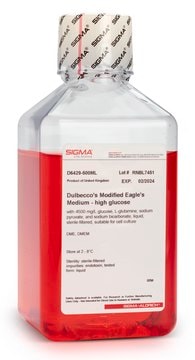R1258
Kpn I from Klebsiella pneumoniae
Restriction Enzyme
Sign Into View Organizational & Contract Pricing
All Photos(1)
About This Item
CAS Number:
MDL number:
UNSPSC Code:
12352204
Recommended Products
grade
for molecular biology
form
buffered aqueous glycerol solution
concentration
10,000 units/mL
shipped in
wet ice
storage temp.
−20°C
Looking for similar products? Visit Product Comparison Guide
Specificity
Recognition sequence: 5′-GGTAC/C-3′
Cutting results: a 2-10-fold Kpn I overdigestion of 1 μg λ DNA substrate results in 100% cutting
Heat inactivation: 65 °C for 15 minutes.
Cutting results: a 2-10-fold Kpn I overdigestion of 1 μg λ DNA substrate results in 100% cutting
Heat inactivation: 65 °C for 15 minutes.
Application
KpnI is a DNA restriction enzyme that is used in molecular biology research to cleave DNA at the recognition sequence 5′-GGTAC/C-3′ to generate DNA fragments with 3′-cohesive termini.
Other Notes
Supplied with 10x Restriction Enzyme Buffer SL (B3782)
Comment: Kpn I shows abnormal DNA cleaving patterns (star activity) in reactions containing high (>5%) glycerol, >5% (v/v); excess enzyme and high pH (>8.0).
The enzyme will not cleave DNA containing 3′-residue of 5-methylcytosine.
The enzyme will not cleave DNA containing 3′-residue of 5-methylcytosine.
Physical form
Solution in 20 mM Tris-HCl, pH 7.5, 0.1 mM EDTA, 50 mM NaCl, 10 mM 2-mercaptoethanol, 50% glycerol (v/v), 0.01% polydocanol (v/v) at 4°C
related product
Storage Class Code
12 - Non Combustible Liquids
WGK
WGK 1
Flash Point(F)
Not applicable
Flash Point(C)
Not applicable
Choose from one of the most recent versions:
Already Own This Product?
Find documentation for the products that you have recently purchased in the Document Library.
Karel De Gendt et al.
Proceedings of the National Academy of Sciences of the United States of America, 101(5), 1327-1332 (2004-01-28)
Androgens control spermatogenesis, but germ cells themselves do not express a functional androgen receptor (AR). Androgen regulation is thought to be mediated by Sertoli and peritubular myoid cells, but their relative roles and the mechanisms involved remain largely unknown. Using
T Welsch et al.
American journal of physiology. Renal physiology, 281(4), F769-F777 (2001-09-13)
Mice lacking the 80-kDa CD2-associated protein (CD2AP) develop progressive renal failure that starts soon after birth with proteinuria and foot process effacement by unknown mechanisms. CD2AP has been identified and cloned independently by virtue of its interaction with the T
J Tomassini et al.
Nucleic acids research, 5(11), 4055-4064 (1978-11-01)
We have determined the recognition sequence of the restriction endonuclease KpnI, previously isolated from Klebsiella pneumoniae. The enzyme cleaves the twofold rotationally symmetric sequence (see book for formula) at the positions indicated by the arrows, producing 3' protruding cohesive ends
C Kessler et al.
Gene, 92(1-2), 1-248 (1990-08-16)
The properties and sources of all known class-I, class-II and class-III restriction endonucleases (ENases) and DNA modification methyltransferases (MTases) are listed and newly subclassified according to their sequence specificity. In addition, the enzymes are distinguished in a novel manner according
Nico Mitro et al.
Methods in molecular biology (Clifton, N.J.), 952, 137-144 (2012-10-27)
The role of certain amino acids in the interactions of ligands with their cognate nuclear receptors is usually achieved by the resolution of the crystal structure of the receptor complexed with the ligand. As a complementary functional approach, site-directed mutagenesis
Our team of scientists has experience in all areas of research including Life Science, Material Science, Chemical Synthesis, Chromatography, Analytical and many others.
Contact Technical Service







